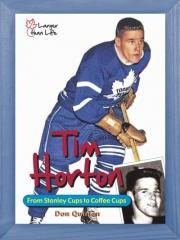
Tim Horton: From Stanley Cups to Coffee Cups. By Don Quinlan. (2010, Markham, Ontario: Fitzhenry & Whiteside. Hardcover. Pp. 72. $22.95 CAN / $19.95 US. ISBN 978-1-55455-148-4.)
As everyone who watches hockey during the playoffs will notice, the NHL prides itself on the league’s history and at this time of year how “history will be made.” Thanks to Don Quinlan’s book, maybe the next ad should read: “History is on the boards.”
A whole generation of hockey fans probably knows Tim Horton more for the donut shops that bear his name than for his tenure with the Stanley Cup winning Toronto Maple Leafs of the 1960s. Don Quinlan’s target audience for Tim Horton: From Stanley Cups to Coffee Cups were not even on their grandparents’, much less their parents’, radars when Tim Horton first hoisted the Cup. However, as many fans will attest, Horton’s name can be found in almost every major hockey arena in the United States and Canada: painted on the boards, advertising the eponymous coffee and donut shops.
Quinlan started the narrative with Horton’s growing up in northern Ontario. Horton’s experiences in life and in hockey were often marked by events where choices had to be made. His father moved the family around a lot in order to find work to support them. For much of his early life, Horton’s family lived in poverty. Eventually, Horton’s father moved the family back to their hometown of Cochrane then onto Sudbury. His father’s choices certainly affected Horton’s early hockey career.
Despite problems with his eyesight, Horton worked hard at hockey and at school. He was invited to play for St. Michael’s College School and made the choice to move to Toronto. When he was given the opportunity to go into the Toronto Maple Leafs system, he moved to Pittsburgh to play with the team’s AHL affiliate. Later on, after Horton got married and started a family of his own, he did whatever he needed to do to support them.
As much as the book is a retelling of Horton’s life and career, it is also a story of overcoming obstacles and working toward success. Despite the eventual financial success of the donut franchise, Horton never gave up on his love for the game of hockey. After years with the Leafs, he played with the New York Rangers, the Pittsburgh Penguins, and, until the night he died, the Buffalo Sabres.
Similar to Melanie Florence’s book about Jordin Tootoo, this book was written for juvenile readers aged 8-14 and Quinlan was careful not to talk down to his audience. His narrative treated readers intelligently. Even when he addressed some of the more sensitive aspects of Horton’s life and career – from the tragic way Horton lost his life to his wife’s issues with addiction – Quinlan told the story in a matter-of-fact way. Although these subjects are often seen as having more of an adult nature, he neither pretended they did not exist nor did he excuse Horton’s behavior.
Tim Horton: From Stanley Cups to Coffee Cups is filled with stats, stories, and photographs that celebrate Horton’s long hockey career. For anyone who has ever been curious about that familiar name on the boards, it is a good read as well as a history lesson on one of the game’s famous names.
Rebecca Dobrinski